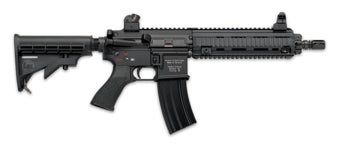Flash animation
Video
Army Times editorial
Discuss
March 4, 2002. An RPG tore into the right engine of an MH-47 Chinook helicopter loaded with a quick-reaction force of Rangers in the Shahikot Mountains of eastern Afghanistan. The Chinook crashed atop Takur Ghar, a 10,000-foot peak infested with al-Qaida fighters.
Enemy fire poured into the fuselage, killing Rangers even before they got off the aircraft. Capt. Nate Self crawled out.
“As soon as I got off the ramp, a burst of rounds fired right over my head,” he recalled.
He joined a handful of his men in the open, exposed to enemy fire. An RPG exploded within a few feet of their position.
“We got up and started firing and moving to some boulders 15 meters away,” he said.
Once behind cover, Self tried to fire again, but his weapon jammed.
Instinctively, he tried to fix it with “immediate action,” a drill he’d practiced countless times.
“I pulled my charging handle back, and there was a round stuck in the chamber,” he recalled.
Like the rest of his men, Self always carried a cleaning rod zip-tied to the side of his weapon in case it failed to extract a round from the chamber.
“There was only one good way to get it out and that’s to ram it out with a cleaning rod,” he said. “I started to knock the round out by pushing the rod down the barrel, and it broke off. There was nothing I could do with it after that.”
The Rangers were fighting for their lives. Self left his covered position and ran under machine-gun fire to search for a working weapon.
“I just got up and moved back to the aircraft because I knew we had casualties there. I threw my rifle down and picked up another one.”
Self was awarded a Silver Star for his actions that day.
When even highly trained infantrymen like Self have problems with their M4 it is a sign there might be a problem with the weapon, not the soldier.
The problems had become obvious enough that at the time of the Afghanistan battle, members of the Army’s Delta Force had begun working on a solution. Today, Delta Force is fighting in Iraq and Afghanistan with a special carbine that’s dramatically more reliable than the M16s and M4s that the rest of the Army dependsupon.
Members of the elite unit linked up with German arms maker Heckler & Koch, which replaced the M4’s gas system with one that experts say significantly reduces malfunctions while increasing parts life. After exhaustive tests with the help of Delta, the H&K 416 was ready in 2004.
Members of the elite commando unit — formally known as 1st Special Forces Operational Detachment-Delta — have been carrying it in combat ever since.
The 416 is now considered in many circles to be the best carbine in the world — a weapon that combines the solid handling, accuracy and familiarity of the M4 with the famed dependability of the rugged AK47.
For the foreseeable future, however, the Army is sticking with the M4 and M16 for regular forces.
The Army plans to buy about 100,000 M4s in fiscal 2008. For this large a buy, each M4 without accessories costs about $800, Colt Chief Executive Officer William Keys said. As part of the contract, though, each M4 comes with a rail system for mounting optics and flashlights, a backup iron sight, seven magazines and a sling — additions that raise the price for each M4 package to about $1,300, according to Defense Department budget documents.
The price of each 416 “will range anywhere from $800 to $1,425 depending on volume and accessories,” said H&K’s CEO John Meyer Jr.
To Col. Robert Radcliffe, the man responsible for overseeing the Army’s needs for small arms, the M16 family is “pretty damn good.” It’s simply too expensive, he said, to replace it with anything less than a “significant leap in technology.”
Since 2000, that leap centered on development of the XM29 Objective Individual Combat Weapon — a dual system featuring a 5.56mm carbine on the bottom and a 25mm airburst weapon on top, capable of killing enemy behind cover at 1,000 meters.
Seven years and more than $100 million later, the 18-pound prototype — three times the weight of an M4 — is still too heavy and bulky for the battlefield.
“We think that somewhere around 2010, we should have enough insight into future technologies to take us in a direction we want to go for the next generation of small arms,” said Radcliffe, director of the Infantry Center’s Directorate of Combat Developments at Fort Benning, Ga.
“We will have M4s and M16s for years and years and years and years,” he said.“We are buying a bunch of M4s this year ... and we are doing it for all the right reasons, by the way. It’s doing the job we need it to do.”
But many soldiers and military experts say this mind-set is off target now that soldiers are locked in a harsh desert war with no end in sight.
“We are not saying the [M4 and M16 are] bad,” said former Army vice chief of staff retired Gen. Jack Keane. “The issue for me is do our soldiers have the best rifle in their hands.”
Before retiring in late 2003, Keane launched a campaign to modernize individual soldier gear after ground troops fighting in Afghanistan complained that they were ill-equipped for the current battlefield. As part of that campaign, Keane backed another effort to give soldiers a better rifle — the XM8, a spinoff of the OICW — only to see it sink last year in a sea of bureaucratic opposition.
“If we are going to build the best fighters, and put the best tanks on the ground, don’t our soldiers deserve, absolutely hands down, the best technology for a rifle?,” Keane said. “Not good enough, but the best.”....
